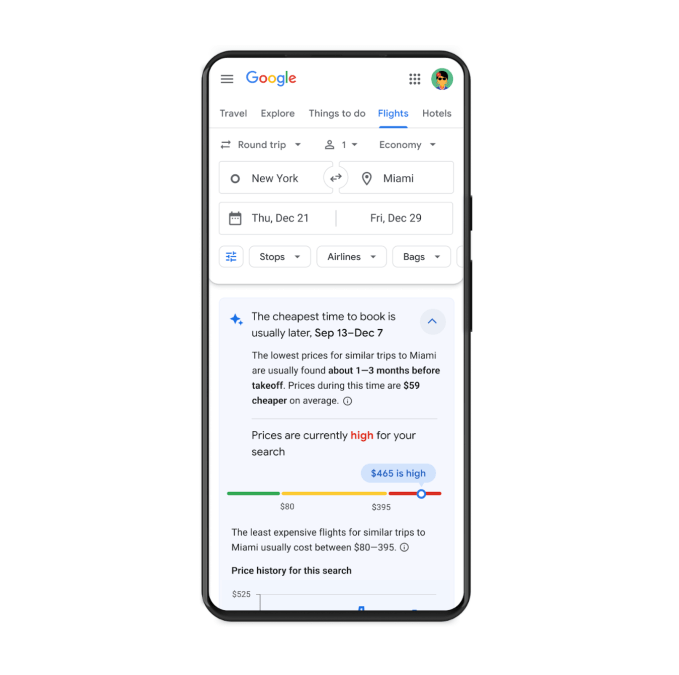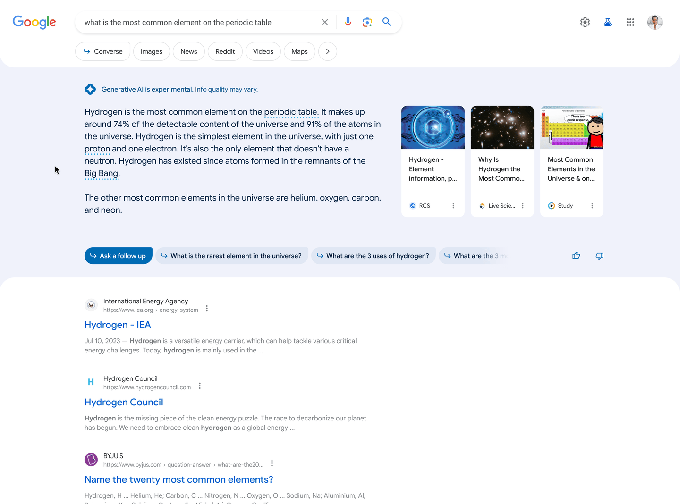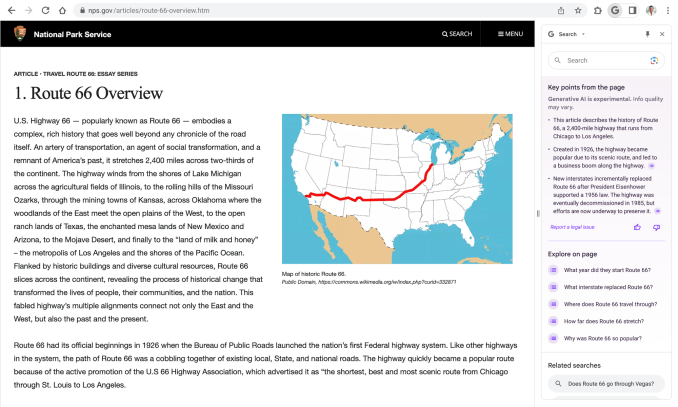S@SThom.as
Google Flights today is releasing a new feature that will help travelers better determine the right time to book. Rolling out this week, the company is debuting new insights that will leverage historical trend data that lets consumers see when prices have typically been lowest to their chosen destination on their selected dates.
The addition aims to help consumers answer the question as to whether it’s better to book their flight now or wait for lower prices.
For example, Google explains, the new insights could tell users that the cheapest time to book their trip is currently two months prior to departure or that, typically, prices for their trip have generally declined closer to the date of departure. With this new understanding of whether or not they’re getting the best deal, consumers may chose to either book immediately or wait for a better price.

Image Credits: Google
The feature complements other insights Google Flights already offers, like the ability to see whether current prices for your search are low, typical, or high, compared to past averages.
In addition, users have the ability to turn on price tracking to receive notifications when flight prices fall significantly for their selected dates or flexible dates, depending on their preferences.
Some flights will also feature a price guarantee badge which means Google is confident the fare won’t get any lower before departure. If it does, Google will refund the difference via Google Play. This is part of a pilot program available for select itineraries in the U.S.
The new “cheapest time to book” insights and other flight savings features were announced today in a Google blog post that also included a look at 2023 flight booking trends, showing the latest data through July 2023.
Among the highlights, it found that for flights around Christmas, average prices have been lowest 71 days before departure, compared with 22 days before takeoff in the 2022 trends report. Plus, there’s no longer a “sweet spot” where prices dip before going back up for U.S. trips to Europe, it found. Prices tend to be lowest 72 days or more before departure, said Google.
Google Cloud’s annual Next event is happening in San Francisco next week (and we’ll be on the ground to cover all of the announcements), but ahead of the event, Google Cloud today put a spotlight on its partner ecosystem. It’s no secret that in its early days, Google’s cloud efforts were somewhat hindered by its inexperience in working with large enterprises and the consultancies, professional service firms and partners they rely on. But when Thomas Kurian took on the CEO role in 2019, he set Google Cloud on a path to build out that expertise and an open partner ecosystem, which is now starting to pay off.
In a blog post today, Google puts its focus on its AI and data services partners like Confluent, DataRobot, MongoDB, Redis, Datastax, Elastic and Neo4j. Given the current hype around generative AI, that’s perhaps no surprise, but this is also the story of Google Cloud learning how to sell to enterprises and embracing more traditional ways of selling to them.
“We have support from the top all the way to the bottom — top-down from Thomas [Kurian] — on us creating the most open ecosystem we can,” Stephen Orban, the VP for Migrations, Independent Software Vendors (ISVs), and Marketplace at Google Cloud, told me. “We build our products and services on open standards and embrace that from a product development perspective, but we’re also making sure we have the most open ecosystem […] where we have ISVs and partners who both complement and extend our platform that we lean into quite heavily — and we view it as a strategic lever for our growth.” When the ISVs grow, Google Cloud grows, after all.
One muscle Google Cloud had to build over the years is co-selling with its partners. In its early days, Google hoped that its technology would essentially sell itself, but these days, the Google Cloud marketplace is stocked with solutions from hundreds of vendors, many of which have close relationships with Google (and the other hyperclouds) to market and sell their products together.
Alan Chhabra, MongoDB’s executive VP for worldwide partners and international sales, noted that he thinks this change is in part due to Kurian’s experience at Oracle. “I was very excited because I knew of Thomas’s history and experience and accomplishments at Oracle. He was an engineering-first CEO but really understood go-to-market. I consider him very similar to MongoDB CEO Dev Ittycheria. They know how to cross engineering with sales better than most CEOs in the world and I felt like Google needed that at the time — because it is a balance.”
He explained that MongoDB quickly established a close business and engineering partnership with Google after Kurian took over. “We had a phone call and in that call, Thomas explained that he wanted to be the cloud that embraced open source,” Chhabra said.
It’s worth noting that at the time, many open-source businesses, including MongoDB, were wrestling with how to react to the likes of AWS releasing their own services based on existing open source projects. It was at Kurian’s first Cloud Next in 2019 that the company announced that it would deeply integrate products from open-source companies like Confluent, DataStax, Elastic, InfluxData, MongoDB, Neo4j and Redis Labs — a list that looks quite similar to the partners the company is highlighting today. While Google didn’t spell it out at the time, that announcement was very much meant to draw a line between how Google Cloud and AWS were going to work with open-source companies.
That approach is now paying off for Google and its partners. “I remember that moment because they were there for the open-source community,” Chhabra said. “They were there for database and data companies like MongoDB and we remember that and loyalty is important to us. Since then, we’ve had phenomenal growth between the two companies, especially in verticals like retail. And we’ve got a commitment with Google and they’ve committed items to us.”
Data is obviously the lifeblood of AI and even though Microsoft, thanks in large parts to its OpenAI partnership, is often seen as a leader, many enterprises specifically use Google Cloud because of its AI services like Vertex AI.
DataRobot CEO Debanjan Saha, who previously worked at AWS and Google, echoed what I heard from other partners as well: “if you look at Google, for a long time, they were a consumer company. The cloud is probably the first enterprise business for them. And there’s a little bit of learning that Google is going through. I think they made a huge amount of progress in the last three or four years, especially after Thomas Kurian took charge of the cloud business. But still, relatively speaking, Microsoft, for example, has been doing that longer than Google has, but I think Google is learning very fast and the gap is closing.”
He noted areas where Google could still improve, including the processes for co-marketing, co-selling, and marketplace execution. “I know that they’re working really hard on those,” Saha added.
Google’s Orban noted that the company often looks for partners who complement its services. “That’s all about recruiting the ISV, making sure they’re well-architected on Google Cloud with their solution. Most ISVs, I would say, lean towards the SaaS model now. They’re building their SaaS in such a way that it is optimized for going to market with us. It’s about building the joint go-to-market together.”
These days, those discussions also often become about generative AI and how Google can help enterprises leverage it. “GenAI has overnight become a CEO- and boardroom-level conversation, where cloud migrations sometimes are traditionally a CIO-level agenda,” Orban said. “So overnight, we’ve seen the demand from customers from very high up in the organization. And we’re in a very fortunate position where a lot of customers have come to trust and recognize Google as a brand for artificial intelligence.”
He noted that while Google has its own foundational models, it still partners with the likes of Anthropic and Cohere. “Our strategy is quite explicit: to build the most open and innovative AI ecosystem on Earth,” he said. “If our customers want to work with a particular partner, we want to be there to support them and make sure that they have a great experience on Google Cloud.”
As companies move to the cloud, keeping data secure is always front of mind. While Google is quick to point out that it has never had an exploit in Google Workspace, it doesn’t mean it isn’t working to continually stay ahead of security issues.
Today, the company announced a number of security-related enhancements to Google Workspace products including GMail and Drive, some of which will take advantage of AI to automate certain tasks. It’s important to understand that these tools are still in development or various stages of testing, but Google plans to add these updates later this year and in early 2024.
For starters, Google wants to enhance its zero trust model, a concept the company helped develop. Google defines zero trust as, “a cloud security model designed to secure modern organizations by removing implicit trust and enforcing strict identity authentication and authorization. Under zero trust, every user, device, and component is considered untrusted at all times, regardless of whether they are inside or outside of an organization’s network.”
As part of that approach, Jeanette Manfra, senior director of global risk and compliance at Google, says the company is announcing a couple of new capabilities that combine the idea of zero trust with the notion of data loss prevention (DLP). “We’re bringing the two together, and adding an ability to improve how you classify using AI capabilities within Drive. And so what this does is it automatically and continuously classifies and labels sensitive data, and then applies appropriate risk-based controls,” Manfra said at a press event this week.
In addition she said that they are adding enhanced DLP controls to Gmail to enable administrators to prevent users from inadvertently attaching sensitive data, especially when it shows up especially in unexpected places. “So say a customer inadvertently sends sensitive data in a customer support email. This allows a Gmail customer to take the controls and sort of raise the bar on their security policies,” she said. For instance, admins could disable download or prevent copy and paste on those documents.
Another big area of focus with these new tools is being sensitive to location and what can be shared, so Google is also adding some context-aware controls in Drive so that admins can set criteria such as a device location that must be met in order for users to share sensitive data.
Andy Wen, director of Product Management for Google Workspace, says that the company is also putting AI to work to help admins peruse log data for data breaches and behavioral anomalies, and to look for suspicious actions in Gmail that could indicate a hacker has gained access to the account.
Data sovereignty in particular is a big problem for companies, who need to ensure that certain information remains within their control. As part of that, the company currently offers client-side encryption on the desktop, but it plans to add it to mobile versions of Gmail, Calendar and Meet and other Workspace tools.
Weir says that central to this is that customers control the encryption keys, meaning that Google can’t see this data, and if law enforcement were to ask, there would be no way for Google to share this information.
“Keep in mind that the key benefit of client-side encryption is it protects your data where regionalization can be inadequate,” he said. “We do it by issuing an additional set of encryption keys that only the customer controls. This additional key encrypts the customer data – we call it from browser to browser – so that Google can never actually see the original content,” he said.
While the company has let customers choose a data residency location when the data is rest in the past, it will now add the capability to choose where to process that data. For starters, that will only include the EU or the United States.
These and other new features are in development and will be released in the coming months. Google was fuzzy on the pricing details, but it will probably depend on the type of account you have, and the particular feature, whether they are included or you have to pay extra.
Google today is rolling out a few new updates to its nearly three-month-old Search Generative Experience (SGE), the company’s AI-powered conversational mode in Search, with a goal of helping users better learn and more sense of the information they discover on the web. The features include tools to see definitions of unfamiliar terms, those that help to improve your understanding and coding information across languages, and an interesting feature that lets you tap into the AI power of SGE while you’re browsing.
The company explains these improvements aim to help people better understand complicated concepts or complex topics, boost their coding skills and more.
One of the new features will let you hover over certain words to preview their definitions and see related images or diagrams related to the topic, which you can then tap on to learn more. This feature will become available across Google’s AI-generated responses to topics or questions related to certain subjects, like STEM, economics, history and others, where you may encounter terms you don’t understand or concepts you want to dive deeper into for a better understanding.
Bing Chat also offers a feature similar to this that lets you highlight the text in question on a page and then select Bing from the options menu to engage in a conversation where you can learn more about the topic.

Image Credits: Google
Another new feature will help those using SGE for programming assistance. The new capabilities will make it easier to understand and debug the generated code, says Google.
Currently, SGE provides AI-generated overviews that help with tasks related to programming languages and tools, allowing users to find answers to their how-to questions or see generated code snippets. The new update will now color-code segments of code with syntax highlights, making it easier to identify different elements like keywords, comments and strings.
SGE while browsing may be the most interesting new addition, but for now, it’s only an early experiment in Search Labs, available on the Google app for Android and iOS and later, Chrome on the desktop.
The feature is designed to help web users engage with long-form content from publishers and creators, to make it easier to find what they’re looking for.

For instance, on some web pages, you can tap to see an AI-generated list of the key points of an article covers with links that take you to directly the part you were looking for.
The page will also include an “Explore on page” option where you can see the questions an article answers and then jump to the relevant section.
The feature is reminiscent of the existing content highlighting search feature that will jump you to relevant text when you search for specific terms and a matching result is found. However, this time, it’s powered by AI.
Rival Bing Chat also already offers a similar feature that lets you tap the Bing Chat icon while reading an article or document online and ask Chat to summarize the content for you — so this, again, is a little bit of catch-up on Google’s part.

Image Credits: Google
Google notes this feature will not provide AI summaries for paywalled articles and publishers can choose to block the feature by designating their content as paywalled in the Help Center.

Image Credits: Google
Google and Bing are not the only ones thinking about how AI can be used to summarize text. News reading app Artifact, from Instagram’s founders, also began offering an AI summary feature as of its April 2023 update.
SGE while browsing is available as a standalone experiment in Search Labs, and will automatically roll out to those who have already opted into to SGE.
The features follow other new additions to SGE including a feature launched earlier this month that now shows related videos and images related to users’ search queries.
Search Labs is available through the Google app on Android and iOS and Chrome on the desktop.
Google Photos is introducing a new way to relive and share your most memorable moments with the introduction of a new Memories view, launching today to U.S. users. The feature lets you save your favorite memories or create your own from scratch in order to build out a scrapbook-like timeline that includes things like your most memorable trips, celebrations, and daily moments with loved ones, the company says.
The addition builds on Google Photos’ four-year-old Memories feature for recalling notable moments from your past via a carousel at the top of the Google Photos app. Today, this works something like a combination of Stories and Facebook Memories, allowing you to flip through favorite photos from past months and years. Google says that feature is now used by more than half a billion people monthly.

Image Credits: Google
The new Memories view allows users to now do more with those favorite moments in a creative way. You’ll be able to add and remove specific photos from your Memories view — or even start a Memories view of your own, without relying on those photos already surfaced by the app. You can also rename the Memories view something of your own, instead of whatever more generic title Google Photos includes — like “Best of August 2013,” for example.
An experimental feature from Google Labs in Photos will also suggest other titles created with generative AI. This is found via the “Help me title” button. If you don’t like the AI suggestions, you can edit them or steer them toward different details to include with an “Add hint” button. Google says this feedback will help the AI get better over time.
However, the AI feature will only be available to select accounts in the U.S. for the time being.

Image Credits: Google
In addition to building out your own Memories timeline, you can invite friends and family to collaborate on the Memories view you’ve created, adding their own favorite photos and videos to the collection, similar to Shared Albums.
The resulting scrapbook-like timeline of photos and videos can then be shared elsewhere on social media, and soon, as videos — an indication that Google has sharing to short-form video platforms like YouTube Shorts and TikTok in mind.

Image Credits: Google
The feature is launching first in the U.S. and will expand to global markets in the months ahead.
Google has filed a new motion to the court in its antitrust battle with Epic Games and Match Group, where it claims that the dating app maker owes additional fees beyond the $40 million that had been previously set aside in escrow. Those funds are Google’s cut of Match’s in-app payments on Google Play that Match argues are “illegal under federal and state law” — something the court case will decide. By Google’s calculations, the new figure should total around $84 million instead, based on Match’s public earnings.
The relevant portion of the filing reads as follows:
Google and Match reached a stipulation in May 2022 resolving a TRO that Match filed in this case. Dkt. 21, No. 3:22-cv-02746-JD. That stipulation allowed Match to continue distributing its apps through the Play store despite its noncompliance with Google’s payments policies, provided that, among other things, Match pay $40 million in payments to escrow. While those payments have now ended, the service fees that Match owes Google substantially exceed that amount. See Match Group Letter to Shareholders, Q1 2022, at 9, 10, https://s22.q4cdn.com/279430125/files/doc_financials/2022/q1/Earnings-Letter-Q1-2022-vF.pdf (noting negative financial impact from Google’s requirement to use its payment system). Google intends to try its counterclaims to recover the full amount it is owed.
The escrow account was one of a handful of concessions from Google to get Match to drop a temporary restraining order it filed after first suing Google, accusing the tech giant of wielding unfair monopoly power in its mobile app marketplace, the Google Play Store. Google also committed to not rejecting or deleting Match-owned dating apps like Tinder, Hinge, OkCupid, and others from the Play Store for providing alternative payment options.
As part of this agreement, Match was to place up to $40 million in the escrow account in lieu of paying fees directly to Google for the in-app payments that take place outside of Google Play’s own payment system while the courts decide whether or not the commissions Google charges app developers on in-app purchases are legal.
But in the new filing, Google argues $40 million is not enough, citing Match’s public earnings. It points to the dating app maker’s shareholder letter for Q2 2022 where the company notes that “While our Q2 Adjusted Operating Income outlook includes an estimated $6 million of negative impact from Google’s policy change beginning June 1st, we need to see the actual effects once the change is implemented.”
Google says that $6 million is what Match owes in fees, but the lawsuit paused the payments. Based on this figure, Google estimates Match owes fees of $6 million per month for the past 14 months, which would total $84 million in fees. That exceeds the $40 million held in escrow, so Google is now planning to try to recover a higher amount in its counterclaims.
“While those payments have now ended, the service fees that Match owes Google substantially exceed that amount,” the filing explains. “Google intends to try its counterclaims to recover the full amount it is owed.”
Match declined to comment.

